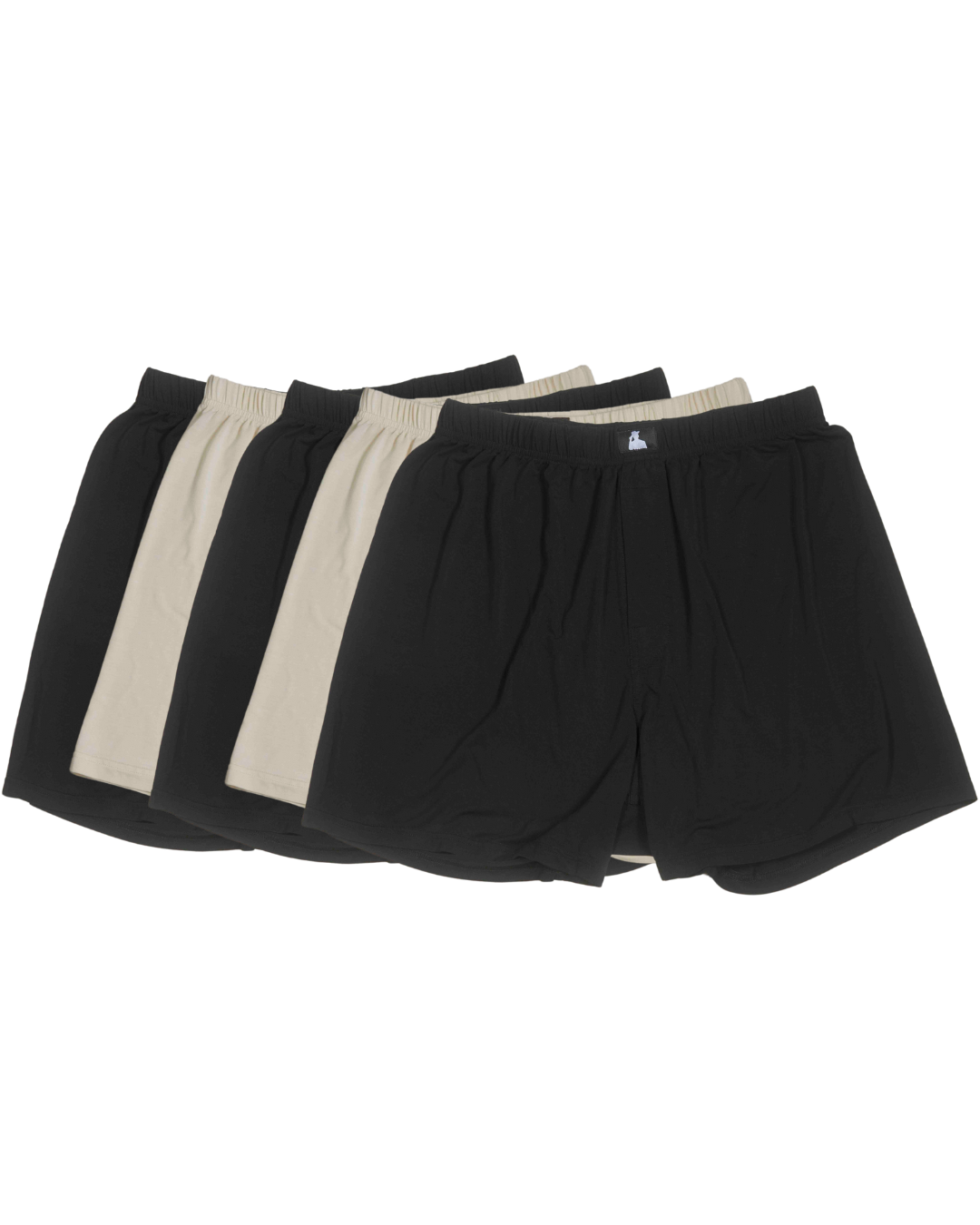Environmentally Safe Boxers: The Future of Sustainable Men’s Underwear
Written By The Mr. Fertyl Research & Education Team
Men’s underwear is undergoing a quiet revolution. For decades, the default has been cotton briefs or synthetic blends treated with various chemicals. But today, a growing movement is pushing for “environmentally safe” boxers that prioritize both sustainability and personal health. These eco-friendly undergarments are made from non-toxic, natural or recycled fabrics and avoid the chemical cocktail found in conventional underwear. The result? Materials that are gentler on the planet and on your body – including potential benefits for male fertility. In this article, we’ll explore why traditional underwear fabrics pose problems, what makes a pair of boxers truly environmentally safe, and how this shift aligns with broader trends in health-conscious, climate-friendly fashion. Along the way, we’ll see how innovative brands (like Mr. Fertyl with its Bamboo Lyocell underwear) are leading the charge in making sustainable men’s underwear the new normal.
The Problem with Traditional Underwear Fabrics
Most mainstream men’s underwear is made from conventional cotton or synthetic materials (like polyester). Unfortunately, both come with environmental and health drawbacks:
- Conventional Cotton: While a natural fiber, standard cotton is resource-intensive. It consumes enormous amounts of water – roughly 8,000–10,000 liters are needed to produce just one kilogram of cotton fabric [2]. This thirst for water has drained rivers and lakes in major cotton-growing regions [2][3]. Cotton farming also relies heavily on pesticides and fertilizers. In 2019, cotton accounted for about 10% of all agricultural insecticide use globally [12]. These agrochemicals pollute soil and waterways, harm wildlife, and pose risks to farm workers and nearby communities [3]. The World Wildlife Fund notes that traditional cotton farming’s use of pesticides and chemical runoff has caused severe environmental damage, such as the degradation of the Aral Sea and other ecosystems [3].
- Synthetic Fabrics (Polyester, Nylon, etc.): Synthetics are essentially plastics made from petroleum. Their production is energy-intensive and involves toxic chemicals. A key issue with synthetic underwear is that it does not biodegrade – every polyester brief could persist for decades or longer in landfills. Even during use and washing, synthetics shed tiny plastic microfibers. It’s estimated that washing synthetic textiles releases between 0.2 and 0.5 million tons of microplastic fibers into the oceans each year [9]. In fact, laundering synthetic clothing is thought to be responsible for about 35% of the microplastics polluting our oceans [9]. These microplastics are ingested by marine life and can enter the food chain, with unknown long-term impacts on environmental and human health.
- Chemical Treatments and Dyes: Both cotton and synthetic underwear are often processed with a variety of chemicals – from dyes and color fixatives to wrinkle-resistant and antimicrobial finishes. Many of these substances are far from benign. Research shows that textile dyes can contain carcinogenic amines and heavy metals, as well as formaldehyde and other toxic substances [4]. For example, some azo dyes can break down into cancer-causing components, and heavy metals like chromium or lead are used as dye fixatives and colorants [4]. These residues don’t just wash out; they can be absorbed through the skin with wear [4]. One study found T-shirts in various colors exceeded safety limits for heavy metals like lead and chromium, prompting calls for stricter regulation [4]. Such chemicals are not only environmental pollutants (ending up in wastewater from factories) but also potential endocrine disruptors or irritants to humans wearing the garments.
It’s clear that the status quo in men’s underwear – water-thirsty cotton reliant on pesticides, or plastic-based fabrics with chemical additives – is neither eco-friendly nor health-friendly. These shortcomings set the stage for a new approach: underwear that minimizes environmental impact and avoids putting harmful substances next to some of the most sensitive parts of the male body.

Clean fabric. Safer choice.
Discover Mr. FertylWhat Makes Boxers “Environmentally Safe”?
“Environmentally safe” boxers aim to solve the above problems. In practice, this means they are made with sustainable materials and processes that benefit the environment and the wearer’s well-being. Key features include:
- Eco-Friendly, Natural Fabrics: Rather than conventional cotton or pure polyester, sustainable boxers use fibers like Bamboo Lyocell, organic cotton, or hemp. Bamboo Lyocell in particular has emerged as a star in eco-textiles. It’s a fabric derived from bamboo pulp via a closed-loop lyocell process. In this process, a non-toxic solvent (N-methylmorpholine N-oxide) is used to dissolve bamboo cellulose, but 99% of that solvent is recovered and recycled instead of being discharged as waste. This dramatically reduces pollution. The resulting bamboo-based fiber is biodegradable, unlike synthetics, and is produced with far less water and energy than cotton. Bamboo as a crop is also extremely sustainable: it’s fast-growing, renews itself after harvesting, and requires no chemical pesticides or fertilizers to cultivate [8]. Because bamboo plants naturally resist most pests and diseases, they can be grown organically with minimal intervention [8]. This means no pesticide residues end up on the fibers (or in the environment). In short, materials like Bamboo Lyocell check all the boxes – renewable source, low-impact processing, and safe for compost at end-of-life.
- Non-Toxic Dyes and Finishes: Environmentally safe underwear avoids the toxic dyes and finishing chemicals common in the industry. They opt for low-impact dyes (which are colorants that meet strict criteria for toxicity and biodegradability) or natural dyes. Importantly, they are free of heavy metals (like cadmium, chromium, lead) and banned azo compounds. Certifications such as OEKO-TEX® Standard 100 are often used to verify this – a textile with OEKO-TEX certification has been tested against over 100 harmful substances to ensure it’s safe for human contact [8]. In practical terms, that means when you wear environmentally safe boxers, you’re not exposing your skin to residues of formaldehyde (from anti-wrinkle finishes) or phthalates and PFAS (from certain performance finishes). Mr. Fertyl’s Bamboo Lyocell underwear, for example, use fiber-reactive dyes that are low-impact and avoid hazardous chemicals, ensuring the fabric touching your skin is as pure as possible. The absence of harsh chemicals also means less risk of skin irritation or allergic reactions and no leaching of toxins when the garment is washed.
- Sustainable Production Practices: Beyond materials, “environmentally safe” also implies ethical, low-footprint manufacturing. This can include using a closed-loop system (as with lyocell) where water and solvents are recycled, implementing renewable energy in factories, and reducing waste (e.g. fabric scraps being recycled). It also often means quality construction – these boxers are made to last, not be thrown away after a few months. Longevity is a sustainability factor in itself: a durable, well-made pair reduces waste over time. Additionally, many brands in this space prioritize fair labor and transparent supply chains as part of the broader ethical fashion movement.
In summary, a pair of environmentally safe boxers will typically be made of a renewable, organic or recycled fabric, processed with minimal chemicals in a closed-loop or organic certified system, and colored with non-toxic dyes. The end product is not only lighter on the planet (lower carbon and water footprint, no persistent pollution) but also safer for you to wear every day.
Health Benefits: Why Non-Toxic, Breathable Underwear Matters for Men
Sustainable underwear isn’t just about saving forests or watersheds – it also carries tangible health benefits for the wearer, especially when it comes to male reproductive health and fertility. Here’s how:
- Reduced Exposure to Endocrine Disruptors: Many chemicals used in clothing (pesticides, phthalates, formaldehyde, certain dyes) are known or suspected endocrine-disrupting chemicals (EDCs). These are substances that interfere with hormonal function. According to the Endocrine Society, EDC exposure has been linked to problems such as altered sperm quality, reduced fertility, and reproductive organ abnormalities [1]. In other words, chronic contact with hormone-disrupting toxins can potentially undermine male reproductive health. Unfortunately, such chemicals can lurk in conventional underwear – for instance, per- and polyfluoroalkyl substances (PFAS) used to make fabrics wrinkle-free or moisture-resistant have been associated with lower fertility rates in studies [5][11]. By choosing underwear made from organic and non-toxic components, you minimize these exposures. There’s peace of mind in knowing your boxers aren’t leaching anything harmful onto your skin. (Indeed, health experts suggest reducing contact with known EDC sources wherever possible when trying to conceive [13].)
- Improved Breathability and Temperature Regulation: One often overlooked factor in male fertility is temperature. Sperm production thrives at a slightly lower temperature than core body heat – that’s why nature designed testicles to be outside the body. If the scrotum is kept too warm for extended periods, sperm count and quality can decline. Tight, non-breathable underwear can contribute to an increased scrotal temperature. The Mayo Clinic explicitly advises men to “[stay] cool” and notes that wearing loose-fitting underwear and avoiding excessive heat can improve sperm quality [7]. Environmentally safe boxers, especially those made from fabrics like Bamboo Lyocell, tend to be highly breathable and moisture-wicking. Bamboo-based textiles have a structure of micro-gaps that allow excellent air circulation and moisture absorption [8]. This means they help keep the groin area dry, comfortable, and cooler. Many men find that bamboo or organic cotton boxers “breathe” much better than polyester blends, which often trap heat and sweat. By preventing overheating, breathable eco-friendly boxers create an optimal environment for the “boys” to function. (And comfort-wise, the softness and thermoregulation of bamboo fabric – which is sometimes likened to a cooler, silkier version of cotton – is a nice bonus!)
- No Harmful Dye Residues on Skin: As mentioned, conventional dyes can leave traces of heavy metals or toxic compounds in fabric. One example is lead, a heavy metal sometimes found in colored textiles, which has well-documented effects on human health. Lead exposure can damage the nervous system and has been shown to affect the male reproductive system (e.g. reducing sperm quality) [4]. Environmentally safe underwear avoids these contaminants by using certified non-toxic dyes. This means less risk of skin irritation (for those with sensitive skin or allergies) and less worry that harmful substances are being absorbed dermally near reproductive organs. Men’s genital skin is delicate, and ensuring only safe, inert materials contact it is a smart move for overall health.
- Supporting Overall Wellness: Indirectly, choosing sustainable underwear can encourage a mindset of health-conscious living. It’s part of caring what goes on and in your body. Many eco-friendly underwear fabrics also have natural properties that can benefit hygiene – for example, bamboo fiber has been noted to resist bacterial growth and odors, reducing the need for antimicrobial chemical treatments [8]. While claims of bamboo’s antimicrobial power vary by processing, users often report that bamboo-based underwear stays fresher longer. Less odor and less need to wash as aggressively means the garment and its wearer stay in better shape. And because these boxers are free of chlorine bleach, formaldehyde, and other finishing chemicals, men avoid possible allergens or carcinogens that they might otherwise absorb through the skin over years of daily wear [4].
It’s worth noting that while more research is needed on some of these connections, early signs are encouraging. In one remarkable experiment, researchers found that dogs made to wear polyester underwear had significant drops in sperm count and motility over 24 months [6]. Once the polyester was removed, the dogs’ fertility measures mostly recovered [6]. The scientists speculated that electrostatic charge from the synthetic fabric may have impaired spermatogenesis [6]. Though this is an animal study, it underscores that the choice of underwear material can have biological effects. The take-home lesson? Choosing non-toxic, breathable natural fabrics for your underwear, as done in environmentally safe designs, is a sensible precaution for protecting male reproductive health. As Dr. Shirisha Avadhanula (an endocrinologist) noted in a Cleveland Clinic discussion, avoiding everyday exposures to endocrine disruptors and toxins – whether in plastics, personal care products, or fabrics – is wise, especially for those planning a family [13].
Aligning with a Sustainable Lifestyle and Future Trends
Beyond the personal benefits, opting for environmentally safe boxers is part of a larger shift in consumer values. People today are increasingly mindful of how products are made, and they expect their purchases to reflect their ethics and health priorities. The fashion industry, in particular, is witnessing a surge in demand for sustainable and ethically-made apparel. According to a 2024 study in Scientific Reports, consumers reported higher perceived quality and value in clothing they knew was sustainably made, and had greater intent to purchase and repurchase such items over traditional apparel [10]. In other words, many men (and women buying for them) now view eco-friendly underwear as premium – it’s seen as better quality, longer-lasting, and more “worth it” than cheap, fast-fashion multipacks. This perception is backed by experience: sustainable materials like Bamboo Lyocell or organic cotton often do feel higher-quality (softer, stronger) on skin, and the craftsmanship from conscious brands tends to be top-notch.
Meanwhile, broad movements like climate change awareness, clean living, and fertility health are converging on our underwear drawer. Choosing organic, toxin-free fabrics is as much a wellness decision as choosing organic food – it’s about reducing unnecessary chemical exposure in daily life. Environmentally safe boxers let men quietly support these values every day. Each time you pull on a pair, you’re saying no to exploitative cotton farming and petroleum-based pollution, and yes to a smarter way of dressing that doesn’t compromise on comfort or style.
This trend is only growing. Major clothing companies have started to introduce sustainable lines, and brands like Mr. Fertyl are raising the bar by specializing in health-oriented, eco-conscious men’s underwear. Mr. Fertyl’s Bamboo Lyocell underwear, for example, are designed for men who care about fertility and fitness – they are ultra-soft, thermoregulating, and free of harmful dyes, making them ideal for those looking to support sperm health while also reducing their environmental footprint. Unlike some competitors that emphasize quick testosterone fixes or gimmicky tech fabrics, Mr. Fertyl takes a holistic approach: improve the environment around your reproductive organs (literally, through better underwear) and you support your natural hormonal balance and fertility. It’s a novel angle in men’s health that complements other lifestyle efforts.

Better for you. Better for earth.
Upgrade TodayThe Future Standard in Men’s Underwear
It’s not a stretch to say that environmentally safe boxers represent the future standard for men’s underwear. They prove that you don’t have to sacrifice comfort or performance to be sustainable – you can have all three: comfort, health, and sustainability. In fact, when done right, they enhance each other. The durability of high-quality eco-fabrics means your boxers last longer (saving you money long-term and reducing waste). Their softness and breathability mean you’ll simply enjoy wearing them more than scratchy, synthetic pairs. And knowing that your choice is better for the planet and possibly your own fertility adds an extra layer of satisfaction.
As more men discover these benefits, it’s likely that ethical and eco-friendly underwear will become the norm rather than the exception. Just as organic food moved from niche to mainstream, so too will organic and bamboo underwear. Early adopters – health-conscious and environmentally-aware consumers – are driving word-of-mouth, and larger retailers are taking note. We can expect innovations to continue in this space: think closed-loop recycling of old underwear into new fibers, even more skin-safe dye technologies, and blends that enhance support and stretch without resorting to plastic-based elastic (research is ongoing into biodegradable elastics). The momentum in textile technology and green chemistry is strong.
In conclusion, environmentally safe boxers are more than a trend – they’re a meaningful improvement to a product that all men use regularly. They address real issues in the fashion supply chain and real concerns for men’s health. By embracing materials like Bamboo Lyocell, low-impact dyes, and thoughtful design, these undergarments show how sustainability and wellness go hand-in-hand. The next time you update your underwear drawer, consider making the switch. Your body – and the planet – will thank you. And if you’re looking for a place to start, Mr. Fertyl’s bamboo underwear is a prime example, marrying eco-savvy fabric with a design ethos centered on male fertility and comfort. This is the future of men’s underwear: clean, green, and actually better in every way.
- Endocrine Society. (2022, January 24). Endocrine-Disrupting Chemicals (EDCs). Source.
- Ahmad, H. S., et al. (2021). Improving Water Use Efficiency through Reduced Irrigation for Sustainable Cotton Production. Sustainability, 13(7), 4044. Source.
- World Wildlife Fund (WWF). (n.d.). Cotton – Environmental Impacts. Source.
- Fanta Sima, M. (2022). Determination of some heavy metals and their health risk in T-shirts printed for a special program. PLOS ONE, 17(10), e0275455. Source.
- Novak, S. (2023, June 13). Fabrics Like Polyester Can Contain a Number of Chemicals That Might Impact Fertility. Discover Magazine. Source.
- Shafik, A. (1993). Effect of different types of textile fabric on spermatogenesis: an experimental study. Urological Research, 21(5), 367-370. Source.
- Mayo Clinic. (2025, March 11). Healthy sperm: Improving your fertility. Source.
- Natural Life Magazine – Mass, E. (2009). Bamboo Textiles: Green, Luxurious and Practical. Source.
- European Environment Agency (EEA). (2023). Microplastics from textiles: towards a circular economy for textiles in Europe. Source.
- Li, M., & Choe, Y. H., & Gu, C. (2024). How perceived sustainability influences consumers’ clothing preferences. Scientific Reports, 14(1), 28672. Source.
- Valvi, D. et al. (2023, June 29). PFAS Exposure Linked to Reduced Fertility in Women. National Institute of Environmental Health Sciences (NIEHS). Source.
- Pesticide Action Network UK. (2022, June 20). Cotton. Pesticide Action Network UK. Source.
- Cleveland Clinic. (2020, August 14). How environmental toxins can impact your health. Cleveland Clinic. Source.

